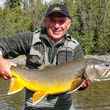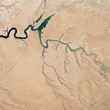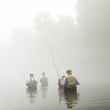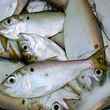Emergers are one of my favorite kinds of flies to fish. This is most likely because, on many an occasion, they've rescued me from a seemingly endless run of failed attempts to match the hatch. It's possible I had indeed failed to properly discern which bug the fish were taking, instead selecting the wrong pattern. Perhaps I had misjudged the size. More likely, my attempts to select the correct dry fly failed because because the fish I was targeting weren't taking duns in the first place. They were taking emergers.
Emergers may well be the easiest type of food source for a trout or other fish to catch as they remain trapped in the surface film, often for extended periods of time. As such, when duns and emergers are both on or in the water, an opportunistic trout will often opt for the easiest meal. Emergers are one of the most effective types of fly patterns, and are underutilized by many anglers. Following are a few thoughts on why you should be fishing emergers, when and where.
An Emerger First
Every dun that emergered through the film to ride high on the surface—and which countless anglers try to imitate with their Catskill, parachute or comparadun patterns—first spent time as an emerger. More importantly, that insect typically spends a great deal more time in the stages its lifecycle that are more accurately imitated by an emerger pattern than a high-floating dun imitation. There's a reason that the Parachute Adams is one of the most popular "dry" flies of all time: it more accurately represents a mayfly nearing the end stages of emergence than it does your typical high-floating dun with hardened wings. You know, the ones which are typically spotted on the surface by anglers, sending us scrambling to our fly boxes in search of the best match.
Cold and Thick
It is important to understand the dynamic that the surface tension of the water plays in regards to emergers. Surface tension of water is the very thing that creates the "film" layer that is so important to fish and anglers alike . The surface tension of water is a major obstacle to mayflies and other insects—a fact often misunderstood by anglers—it is a membranous, thick, plasticy substance in which emerging insects struggle greatly. This is precisely why emergers are so susceptible to trout and other predators: they're stuck.
And, when the water is cold, they're stuck even more. As water temperature drops, surface tension increases. Additionally, water temperature is not the only temperature relevant to the "thickness" of the film, with air temperature also playing an important role. As air temperature increases, the dynamics of the interaction between the water's surface and the air—a crucial factor in determining surface tension—change, with warmer air temperatures also producing a "thinner" film. While these effects may or may not be pronounced, it is probably safe to assume that insects that emerge in colder water or on colder days have a harder time of it—and thus spend more time struggling just below the surface—than those that emerge in warmer conditions.
Riffles and Rapids and Runs
Stream flow and structure also play an important role in regards to surface tension. Essentially, broken, fast water is an emerging insect's friend. The tiresome work of breaking through the film is made easier by rough water, as rapids, riffles and the like break the surface film and give insects the opportunity to more easily escape. Though I've had great success with emerger patterns (as well as wet fly patterns) in riffles, these are not the places of high emerger concentrations. Along these lines, in flat, still water, the surface film is at its most pronounced and you're almost certain to find more emergers in these areas of the stream.
Wrapping Up
If you're struggling to match the hatch, left scratching your head on the stream while rising fish repeatedly sip, slash, and gulp at something—seemingly anything—other than the lengthening list of dry fly patterns you've offered them, try an emerger. You might be surprised at the results.































Comments
PoconoTrout replied on Permalink
Chad - I'm actually of the opinion that most "match the hatch" problems actually come down to tossing out a dry instead of an emerger. As you mention, bugs spend more time trying to get onto the surface than they do actually riding it. It seems like the math would suggest that most rising fish are after emergers then, doesn't it?
DDon replied on Permalink
it probably means more fish are taking emergers more often than people realize, but that doesn't mean that its a rule.
the rise form of a fish in question can be very telling to whether they're taking emergers or dries
Aileen Lane replied on Permalink
My favorite patterns to tie and fish with are emergers with a nymph dropper because I find I have most success with them!
Chase Hansen replied on Permalink
Colorado trout love!!
Fred Rickson replied on Permalink
Interesting fact; for many years, when the Callibaetis spinners are covering the surface, most folks fish a parachute Adams to the famous Hebgen Lake gulpers. You say emerger, we say dead spinner, tomato-tomaaato, potato-potaaato, etc.
Pages